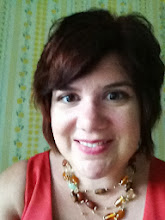Menand's article Show or Tell: Should Creative Writing be Taught? made me recall my first creative writing course at Magnificat High School several years ago. As a senior, I had originally registered to continue my foreign language studies in a Spanish IV course. However, I impulsively decided prior to the commencement of the class that I wanted to take a risk and move beyond my comfort zone of traditional coursework. Enrolling in a semester of Ceramics and Sculpture in fall term, and then Creative Writing in spring, was the opportunity I needed and desired to find my "voice" as a student, artist, and writer.
I agree with Menard that "few activities make people more self-conscious than participating in writing workshop. Reflecting on yourself-your experience, your "voice", your background, your talent or lack of it-is what writing workshops make people do" (2009, p. 109). The creative writing course I took did not focus on teaching the mechanics of writing or the conventions of print. The foundations of those concepts had been laid many years prior to my enrollment in the class. However, what I did learn was how to express myself in a variety of styles and genres. Most importantly, I learned to share my words and experiences with others. I was initially surprised by the interest others gave to my writing, and I learned to accept compliments and constructive criticism, as well.
As an English teacher for twelve years, educating fourth and fifth graders, I conducted many Writer's Workshops in my classroom. I was always pleasantly surprised with with how willing my students were to share their words with their teacher and peers. At their age, I was always hesitant. However, I realized that the child-centered structure of my classroom enabled my students the atmosphere to be themselves without fear of making a mistake or being judged. Students learned the valuable lesson of listening to others' words and giving constructive feedback. They also had the opportunity to see me write and listen to my words. "Teachers are the books that students read most closely, and this is especially true in the case of teachers who are living models for exactly what the student aspires one day to be-a published writer", (Menand, 2009, p. 112). It is my hope that these lessons and examples were carried with them into the junior high years and beyond.
I cannot answer the question, Can creative writing be taught? There will always be some students who have an inherent talent for writing, as others do for mathematics or science. However, some students need more guidance, patience, practice, and opportunities to hone their craft. Picasso one said that, "Every child is an artist." I believe that all children are writers, as well, with multiple stories to tell. We must enable our students the chance to take a risk, write, share, and find their true "voice".
Thursday, January 28, 2010
Subscribe to:
Post Comments (Atom)


I do not necessarily agree with Menand when he claims that a student's goal is to be a published writer. I think of Ortega y Gassett and his work "The Dehumanization of Art." Sometimes a creative writer's or artist's purpose is only for the creation of art and not for its dissemination to the public. I think that the question of whether or not creative writing can be taught first needs to define (yes, my favorite angle!) what the goal of creative writing is. It seems to me that goals are as creative and original as the piece of art itself.
ReplyDeleteI agree that teaching creative writing is a difficult 'art' to teach. When I dialogue with art teachers I try to understand the ways they grade or instruct in their classrooms because I believe there are so many parallels between teaching creative writing and teaching art. Grading writing is always subjective; however, I've found assesssing creative writing to feel extremely subjective...especially since I'm not a great out-of-the-box thinker myself.
ReplyDelete